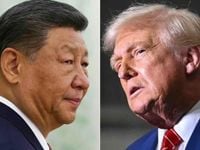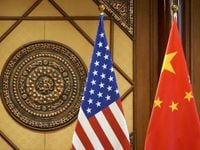It’s been another tumultuous week on the global economic stage, as China and the United States—still the world’s two largest economies—agreed on October 18, 2025, to resume high-level trade negotiations in the coming days. The move comes as both sides scramble to avoid a fresh round of damaging tit-for-tat tariffs, with the clock ticking toward a critical November deadline and tensions running high over China’s recent export controls on rare earth minerals.
According to Xinhua and multiple international outlets, the breakthrough came after a Saturday video call between US Treasury Secretary Scott Bessent and Chinese Vice Premier He Lifeng. The conversation, described by both parties as “candid, in-depth and constructive,” also included US Trade Representative Jamieson Greer. Bessent summarized the exchange on social media, saying, “We will meet in-person next week to continue our discussions.” He added that the talks were “frank and detailed,” a phrase echoed by Chinese state media, which reported both sides had agreed to hold the next round of negotiations “as soon as possible.”
The urgency is palpable. Just last week, Beijing announced sweeping new controls on the export of rare earth elements—materials vital for everything from smartphones and electric vehicles to sophisticated military technology. In response, President Donald Trump threatened to slap 100 percent tariffs on all Chinese imports, a move that could take effect as soon as November 1 unless China rolls back its restrictions. “It’s not sustainable, but that’s what the number is... They forced me to do that,” Trump told Fox Business in an interview aired on October 17, 2025, underscoring the high stakes for both economies.
The threatened tariffs would come on top of a fragile truce negotiated over the past six months, which saw both countries gradually reduce their previously triple-digit duties. That agreement, hammered out during meetings in four European cities, is set to expire on November 10, 2025. Without a new deal, the risk of a renewed trade war looms large—potentially disrupting global supply chains and rattling markets worldwide.
For the US, the rare earths issue is especially sensitive. These minerals are essential for manufacturing high-tech goods and defense systems, and China currently dominates global supply. Bessent has not minced words about the impact of Beijing’s move, accusing China of seeking to “harm the rest of the world” by tightening its grip on these critical exports. US officials have also warned that new American export controls could soon halt supplies of “any and all critical software” to China, further escalating the standoff.
Yet, it’s not just Washington and Beijing feeling the heat. The Group of Seven (G7) finance ministers—representing Britain, Canada, France, Germany, Italy, Japan, and the United States—met this week in Washington to discuss a coordinated response. According to EU Economy Commissioner Valdis Dombrovskis, the ministers agreed to “coordinate a short-term response and diversify suppliers,” though he acknowledged that shifting away from Chinese rare earths could take years. “We agreed, both bilaterally with the US and at the G7 level, to coordinate our approach,” Dombrovskis told reporters. In the meantime, countries will exchange information on their contacts with Chinese counterparts as they work out short-term solutions.
German Finance Minister Lars Klingbeil expressed hope that an upcoming meeting between Trump and Chinese President Xi Jinping—expected to take place on the sidelines of the Asia-Pacific Economic Cooperation (APEC) summit in South Korea later this month—could help defuse the situation. “We have made it clear within the G7 that we do not agree with China’s approach,” Klingbeil said, adding that a resolution would benefit the entire global economy. International Monetary Fund chief Kristalina Georgieva also voiced optimism, saying she hoped for an agreement that could “cool tensions.”
For a moment, it seemed the diplomatic calendar might be upended. Trump had initially threatened to cancel his anticipated meeting with Xi at the APEC summit, using it as leverage in the ongoing dispute. But in his Fox News interview, he confirmed the meeting would go ahead, albeit under the shadow of the threatened tariffs. The world will be watching closely as the two leaders sit down—a reminder of how personal relationships at the top can shape the fate of millions.
Behind the scenes, the current crisis is just the latest flare-up in a trade war that has simmered for years. Earlier in 2025, Trump’s return to office brought with it a promise of sweeping tariffs on Chinese imports, reigniting hostilities that had only recently cooled. At the height of the conflict, tariffs on both sides soared to triple-digit levels, grinding some sectors of cross-Pacific trade to a halt as companies waited for clarity. Although both countries have since eased some levies, the truce remains shaky, with businesses and investors nervously eyeing each new headline.
Rare earths are far from a household topic, but their importance can’t be overstated. These elements are the hidden engines behind much of modern technology—smartphones, electric cars, lasers, wind turbines, and even the magnets in guided missiles. China’s near-monopoly on production gives it enormous leverage, and any disruption sends ripples far beyond the two countries’ borders. Diversifying supply is a long-term project; as Dombrovskis pointed out, “the vast majority of rare earth supplies come from China, meaning that diversification could take years.”
So what happens next? All eyes are on Malaysia, where Bessent and He Lifeng are set to meet in person next week. The choice of venue is telling—Malaysia is a major exporter in its own right, with deep trade ties to both China and the US, and is itself caught in the crossfire of threatened US tariffs on semiconductors and electronics. The outcome of these talks could determine whether the world’s two economic giants step back from the brink or slide into another round of costly confrontation.
Meanwhile, the G7 and other global players are preparing for all scenarios, coordinating strategies and sharing intelligence as they brace for potential shocks. Businesses, too, are hedging their bets, stockpiling key materials and exploring backup suppliers, even as they hope for a diplomatic breakthrough.
As the November deadlines approach and the world waits for the next move, the stakes could hardly be higher. The coming weeks will test not just the mettle of negotiators, but the resilience of the global economy itself.

